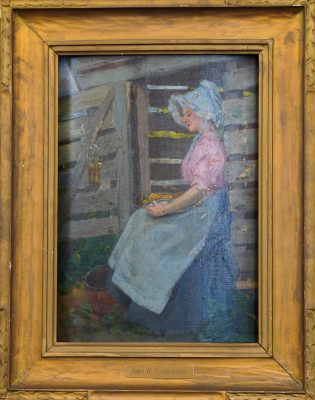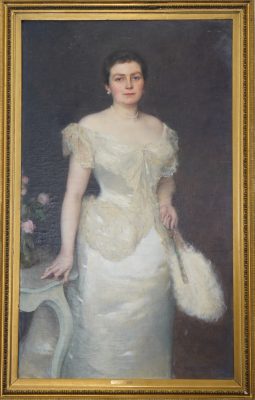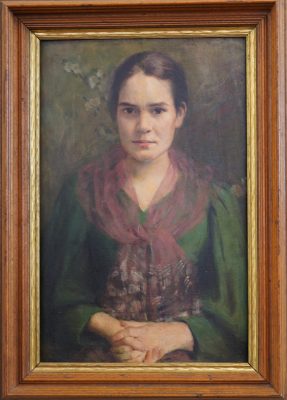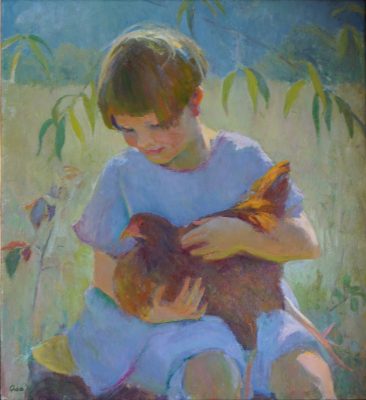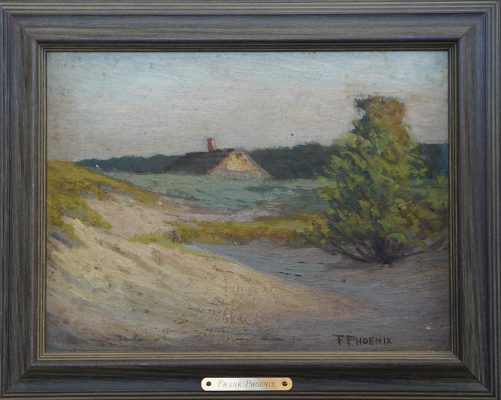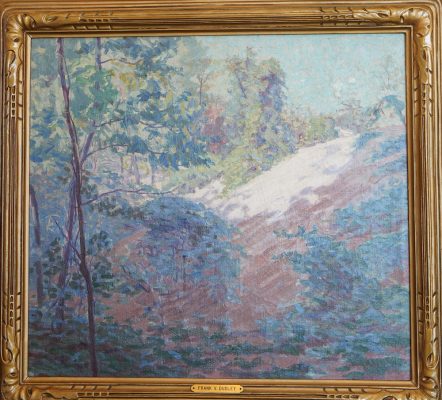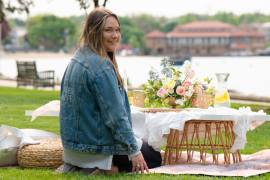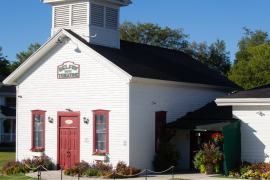By Nat Wexler and Anne Morrissy | Photos by Holly Leitner
Did you know? For a period of around 20 years, between 1890 and 1910, Delavan served as a summer haven for artists, many of whom received their artistic training at the School of the Art Institute of Chicago (SAIC). Prominent artist and figure drawing instructor John Vanderpoel taught at SAIC from 1880 to 1910, and he also maintained a summer home in Delavan, where he hosted groups of students every July. In addition to this student- artist colony, many local, Delavan-born artists trained at SAIC and in Europe, and went on to establish studios and give lessons in Delavan. These local artists created an impressive body of work — mostly portrait and landscapes executed in the popular Impressionist style — many of which remain today in the collection of the Aram Public Library, where several can be viewed during the library’s open hours free of charge.
Many of the paintings on display match the quality of other works by these same artists which reside today in the collections of the Brooklyn Museum of Art, the Art Institute of Chicago and the Weisman Art Museum in Minneapolis, among others. In fact, according to Library Director Michelle Carter, this impressive art collection at the Aram Public Library rivals that of many small museums. It’s a “strong representation of the area’s history and its artists,” she says.
All of the works in the library’s collection are donated pieces. Each year, the Blooming Prairie chapter of the Questers provides grant money toward the art’s restoration, allowing for paintings to be cleaned and restored by Milwaukee-based CPR Art. Currently, the number of paintings far exceeds the wall space available in the historic library building, but the Aram Public Library is sponsoring a capitalcampaigntoraisefundsforthe construction of a new library space. Once that happens, Carter hopes to rotate the collection and host special displays, allowing visitors to view more of the art on a regular basis.
The current display offers a nice introduction to these influential artists. Some of the highlights include:
“Woman Shelling Corn” by John Vanderpoel.
Born in the Netherlands in 1857, Vanderpoel immigrated to the United States at the age of 12 and studied at the Chicago Design Academy (later SAIC), eventually returning to Europe to study art in Paris for two years. In his early career, he became a decorated artist in his own right, but he achieved his greatest acclaim as an instructor at SAIC, a role he began in 1880. He was revered for his 1907 textbook, “The Human Figure,” which became a standard art school textbook around the country. Vanderpoel began conducting classes in Delavan in the summer of 1892, and for the next 18 years, these classes helped to foster the artist’s colony in Delavan.
“Portrait of Mary Gordon Landon Pratt” by William Thorne.
This large-scale portrait of a prominent society woman painted in 1893 demonstrates the artist’s impressive portrait style. Thorne was born in Delavan, studying at SAIC and traveling to Europe for additional training before opening a studio around 1902 in Carnegie Hall in New York City. (He is rumored to have shared studio space with the famous portrait painter John Singer Sargent.) During this period, Thorne achieved his greatest success as a society portrait painter, receiving commissions from prominent families like the Goulds, Carnegies and Mellons, as well as the British aristocracy. Thorne eventually returned to Delavan. The library holds two of his paintings.
“Portrait of a Girl with a Red Scarf” by Adolph Shulz.
Born in Delavan in 1869, Shulz studied art in Chicago and New York before returning to his hometown. In the early 1890s, Shulz met his first wife, Ada Walter, when she attended Vanderpoel’s Delavan workshop. Immediately following their wedding, the two traveled to Europe, where Adolph studied art at the Academie Julien in Paris. After the birth of their son, the Shulzes returned to Delavan, where Adolph maintained a studio. In 1918, Adolph and Ada Shulz moved to Brown County, Indiana. While there, Shulz fell in love with an art student and single mother named Alberta Rehm, and asked Ada for a divorce. He was remarried to Rehm, and the two moved to Sarasota, Florida, where Shulz took a position with the Ringling Museum of Art.
“Child and Red Pullet” by Ada Walter Shulz.
Ada Walter was a student of John Vanderpoel’s at SAIC when she came to the Delavan workshop and met Adolph Schulz.The two were married in September 1894, and Ada studied at the Academie Vitte in Paris after that. She gave birth to their son Walter in 1895 and resumed her painting career in 1906, preferring to paint Impressionist portraits of children and mothers, often incorporating a bolder use of color than her male colleagues. In 1918, she moved with Shulz to Brown County, Indiana. Following their divorce, she returned to Delavan, where she remained until her death.
Untitled landscape by Frank Phoenix.
The artist with the deepest ties to Delavan is Frank Phoenix, grandson of one of Delavan’s founders. Phoenix ran a local wallpaper business before selling it and moving to Chicago to study painting at the Art Institute. He then continued his studies in Paris. Phoenix specialized in landscapes, particularly those depicting scenes in the evening.
Untitled dune landscape by Frank Dudley.
Born in Delavan in 1868 to deaf parents who met at Delavan’s Wisconsin School for the Deaf, Dudley studied art at SAIC and eventually took up landscape painting. In 1905, he was awarded the Art Institute’s prestigious Young Fortnightly Prize. In 1911, Dudley was introduced to the area that today makes up the Indiana Dunes National Park and opened a studio there. Dudley became known as the “Painter of the Dunes,” using the surrounding landscape as a frequent subject of his paintings, and was an early advocate for the area’s natural preservation.

